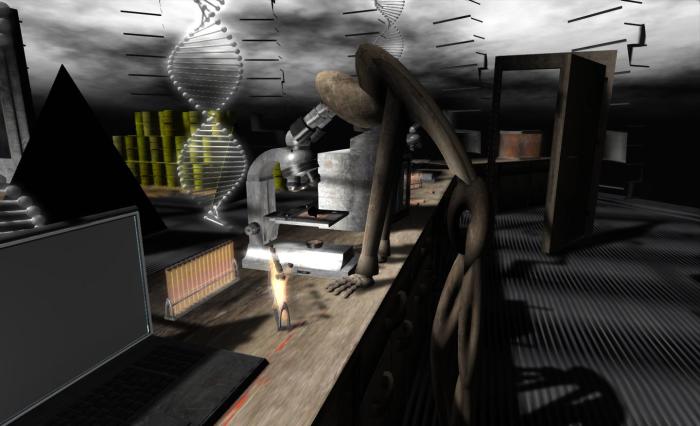This month sees the third round of the Linden Endowment for the Arts Artist-in-Residence programme drawing to a close. With applications for round 4 now open, I thought it time I caught-up on some LEA-related posts on various exhibits which have been in draft form over the past for weeks and got them blogged.
Given that science forms the basis for a large part of my non-SL posts here, I thought I’d begin with Kicca Igaly and Nessuno Myoo’s Danger in Evolution, currently on display at LEA27.

The artists describe the work, which comprises two separate but interlinked installations by each of them respectively, as:
The contradiction that is at the heart of any technological and scientific evolution when there is not growth, maturity and an awareness of value potential risks that this implies evolution in the life of everyone. Especially when interests of prevarication or economic, social, religious interests come into play.
It’s a dark piece – literally, given the recommended windlight settings and overall hue and tone of the builds themselves – which is both provocative and rich in imagery, challenging us to consider the ethical, moral and religious challenges, both positive and negative, inherent both in the pursuit of science and technological development.

Nessuno Myoo presents us with a scene which is both chaotic and yet potentially joyful – a huge carousel-like ball on which people ride. From a distance all seems to be fun and laughter – but as one draws closer, it is apparent that this is not the case. Those riding the carousel are perhaps not really in control, but are perhaps trapped by the very thing they sought to create.
Closer examination still reveals that the carousel is far from innocent; at its heart lay a representation of of the atomic structure of uranium 235, of which the nucleus is that of “Little Boy”, the first atomic weapon ever used in anger, which exploded over the city of Hiroshima on August 6th, 1945. This brings the carousel’s design into sharp relief – it is in fact the mushroom cloud of a nuclear explosion, and thus the surrounding chaos can be understood, as can the myriad of eyes witnessing the scene.

In her piece, Kicca Igaly continues the nuclear theme central to Nessuno’s work, as she presents a piece depicting nuclear research, wherein those performing the work are seemingly oblivious to the fact that while they have the benefit of every protection which can be afforded them in their work, the real nightmare is already out in the world in the form of nuclear waste which is poisoning the world, and ruining lives, as shown by the two children who innocently play with toxic waste, themselves seemingly oblivious of their own missing parts…
The children are perhaps a link into the second aspect of Kicca’s work, as she also presents a tableau depicting genetic research as a scientist, surrounded by models of DNA, peers steadfastly into a microscope. Will he find a new means of aiding the sick or overcoming sickness – or will his research result in further chaos and destruction? As Kicca notes, “The timing of the research are often too short to fully evaluate the consequences of what is produced afterwards. I wanted to emphasize in these scenes, that these aspects need to be taken into extreme account by researchers and by who finances them and often influence their activities, with cursory expectations. ”

Of course, scientific and technological advancement are often rarely without risk. That does not mean we should turn out backs on either – and neither Kicca nor Nessuno are implying we should. But we have reached a point in our own understanding of both science and technology where we do need to be more aware of both the broader potential and impact of scientific discovery and development. As such, we perhaps move to free ourselves from both the imperatives of financial gain arising from research and – equally – the religious ignorance which often prevails against the potential for life-saving / life-enhancing research and development, and look upon things in a broader light – particularly where our endeavours can have such a wide-ranging impact on both our evolution and on the world around us.
Danger in Evolution is a powerful, evocative piece, however one looks at it, both directly and indirectly. The imagery is both intense and also subtle, challenging us to consider matters of evolution, development, research and science from all parts. Walking through Nessuno’s part of the installation in particular, I could not help but hear Oppenheimer’s quote when looking back on the detonation of the very first A-bomb during the Trinity tests in New Mexico, when he referred to a passage from the Bhagavad Gita, “Now, I am become Death, the destroyer of worlds.”
This is also a piece that again demonstrates the sheer power of environments such as Second Life for staging immersive works of art which can so challenge our perceptions and thinking – and as such, it is not one to be missed.

I finally went there to visit the exhibit. To say that it’s dark is an understatement; it’s bleak and dystopian, far removed from the mainstream way in which all scientific projects are presented. It’s sobering, to say the least. The carousel’s design is, of course, highly symbolic and should stir a few consciences.
The part with the researchers is perhaps even more disturbing, as these stylized figures are shown to be not only oblivious, but deliberately turning a blind eye on the side-effects of their work (or, even worse, its usage).
LikeLike